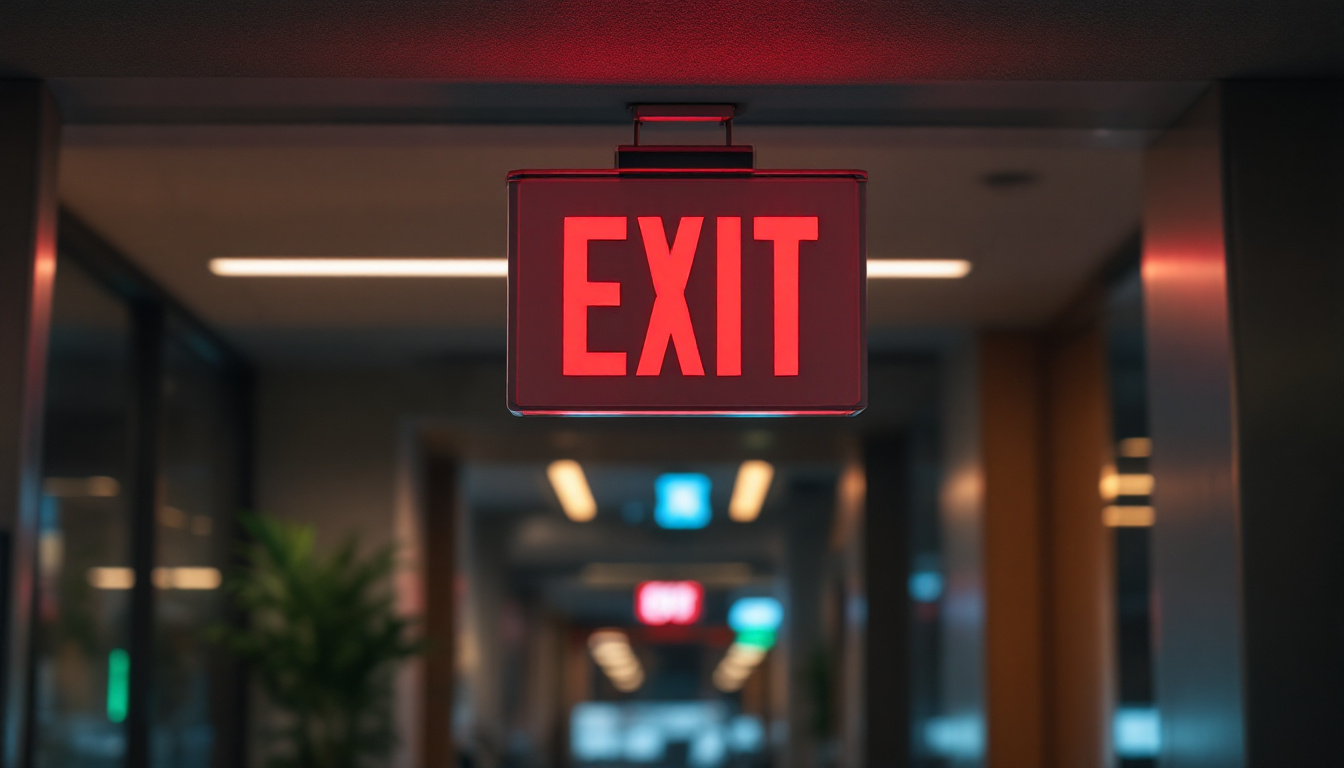
In the realm of commercial and residential lighting, exit signs hold a critical role in ensuring safety and compliance with local regulations. For lighting contractors, understanding the nuances of exit signs is essential not only for installation but also for maintenance and upgrades. This article delves into the various aspects of exit signs that every lighting contractor should be familiar with.
Exit signs are not merely decorative elements; they are vital safety features that guide occupants to safety during emergencies. Their primary function is to provide clear and visible directions to exits, especially in low-light conditions. This is crucial in preventing panic and ensuring a swift evacuation. In many cases, the presence of well-placed exit signs can mean the difference between a safe escape and a tragic outcome. Their strategic positioning throughout a building, particularly in areas such as hallways, stairwells, and near exits, is essential to facilitate an efficient evacuation process.
Furthermore, exit signs are often complemented by additional safety features, such as emergency lighting systems, which illuminate pathways leading to exits. This combination not only enhances visibility but also reassures occupants that they can safely navigate their way out of a building during a crisis. Regular maintenance and testing of these systems are crucial to ensure they function correctly when needed most, underscoring the importance of a comprehensive safety plan in any establishment.
Every lighting contractor must be aware of the legal standards governing exit signs. The National Fire Protection Association (NFPA) and the International Building Code (IBC) set forth guidelines that dictate how exit signs should be installed and maintained. These regulations often specify the size, color, and illumination of exit signs, ensuring they are easily recognizable in an emergency. The standard green or red colors, along with the universally recognized “EXIT” lettering, are designed to catch the attention of individuals in distress, making it easier for them to locate the nearest exit quickly.
Moreover, local building codes may impose additional requirements that vary by jurisdiction. Contractors should always verify these codes to ensure compliance, as failure to do so can lead to significant liabilities and safety hazards. Regular inspections and audits of exit signs and emergency lighting systems are also recommended to ensure ongoing compliance with evolving safety standards. This proactive approach not only safeguards the occupants but also protects the property owners from potential legal repercussions associated with non-compliance.
Exit signs come in various types, each suited for different environments and applications. Understanding these types allows contractors to recommend the best solutions to their clients. The most common types include:
Additionally, there are also specialty exit signs designed for specific environments, such as those used in industrial settings, where they are often constructed from durable materials to withstand harsh conditions. In healthcare facilities, exit signs may feature braille and tactile elements to assist individuals with visual impairments. Understanding the unique needs of different environments is essential for contractors to provide tailored solutions that enhance safety and accessibility for all occupants.
As technology evolves, new innovations in exit signage continue to emerge, such as smart exit signs that can integrate with building management systems. These advanced systems can provide real-time updates and alerts during emergencies, further improving the safety and efficiency of evacuations. By staying informed about the latest developments in exit sign technology, contractors can ensure they are offering the most effective and reliable solutions to their clients, ultimately contributing to safer buildings and communities.
Proper installation of exit signs is crucial for their effectiveness. Lighting contractors must adhere to specific guidelines to ensure that exit signs are placed in optimal locations and heights.
Exit signs should be installed above doorways leading to exits, and their placement should be clearly visible from any direction within the building. A common rule of thumb is to position the signs at least 80 inches above the floor to avoid obstruction. Additionally, signs should be placed at regular intervals in larger spaces, such as hallways or auditoriums, to ensure visibility from all areas. It is also important to consider the color and design of the exit signs, as these can significantly impact their visibility. High-contrast colors, such as white lettering on a green background, are recommended for maximum readability, especially in low-light conditions.
For illuminated exit signs, proper electrical connections are essential. Contractors should ensure that the signs are connected to emergency power sources, allowing them to function during power outages. This often involves integrating the exit signs with the building’s emergency lighting system. Additionally, it is advisable to use signs that comply with local building codes and standards, which may dictate specific requirements for electrical installations. Regular inspections of the wiring and connections can help prevent malfunctions and ensure that the exit signs remain operational when they are needed most.
When installing battery-operated exit signs, it is crucial to check that the batteries are easily accessible for maintenance and replacement. Regular testing of these systems is also necessary to ensure reliability in emergencies. It is beneficial to establish a routine maintenance schedule that includes testing the functionality of the signs, replacing batteries as needed, and ensuring that the signage remains clean and unobstructed. Moreover, educating building occupants about the location and significance of exit signs can enhance overall safety, as individuals will be more likely to recognize and follow these critical indicators during an emergency situation.
Once installed, exit signs require ongoing maintenance to ensure they remain functional. Regular testing and inspections are vital components of this process.
Lighting contractors should recommend routine inspections of exit signs to check for any signs of wear, damage, or malfunction. This includes checking the illumination levels, ensuring the signs are clean and visible, and verifying that they are securely mounted. Regular inspections can help identify issues before they become critical, ensuring the safety of building occupants. Additionally, it is important to assess the surrounding environment of the exit signs; for instance, any obstructions that may hinder visibility during an emergency should be promptly addressed. This proactive approach not only enhances safety but also contributes to the overall preparedness of the facility in case of an evacuation scenario.
Most building codes require exit signs to be tested at least once a month. This involves simulating a power outage to ensure that the exit signs illuminate properly. Contractors should document these tests and keep records to demonstrate compliance with safety regulations. Furthermore, it is advisable to involve staff in these testing procedures, as familiarizing them with the exit signs and their operation can significantly improve response times during an actual emergency. Training sessions can be organized to educate employees about the importance of exit signs and the procedures to follow in case of an emergency, reinforcing a culture of safety within the organization.
In addition to monthly tests, a comprehensive annual inspection should be conducted, including a review of the entire emergency lighting system. This thorough approach helps maintain the integrity of the exit signs and ensures they function as intended during emergencies. During these annual inspections, it is also beneficial to evaluate the overall layout and placement of exit signs throughout the building. As renovations or changes in occupancy occur, the effectiveness of existing signage may be compromised, necessitating adjustments to ensure optimal visibility and compliance with current safety standards. By regularly updating and maintaining exit signs, facilities can create a safer environment for all occupants.
As technology advances, so do the options available for exit signs. Lighting contractors should stay informed about the latest innovations that can enhance safety and efficiency.
Smart exit signs are an emerging trend in the industry. These signs can connect to building management systems, providing real-time data on their operational status. In the event of a malfunction, notifications can be sent to maintenance teams, allowing for prompt repairs.
Additionally, smart exit signs can be programmed to change their messaging based on the situation, providing dynamic guidance during emergencies. This adaptability can significantly improve evacuation procedures and overall safety.
With a growing emphasis on sustainability, energy-efficient exit signs are becoming increasingly popular. LED and solar-powered options not only reduce energy consumption but also offer longer lifespans compared to traditional incandescent signs. Contractors should consider these options when recommending exit signs to clients, as they can lead to significant cost savings over time.
In summary, exit signs are a critical component of building safety that lighting contractors must understand thoroughly. From legal compliance and installation best practices to ongoing maintenance and innovations in technology, there is much to consider. By staying informed and proactive, contractors can ensure that their clients’ exit signs are not only compliant but also effective in guiding occupants to safety during emergencies.
As the landscape of building safety continues to evolve, lighting contractors who prioritize knowledge and expertise in exit signs will be better positioned to serve their clients and enhance overall safety in the spaces they illuminate.
Ready to elevate the safety and compliance of your lighting projects? Look no further than LumenWholesale for all your exit sign needs. Our extensive selection of top-quality, spec-grade lighting products comes at unbeatable wholesale prices, ensuring you get the best value for your investment. Say goodbye to inflated markups and hello to reliable, high-performance lighting that meets the highest industry standards. Plus, with free shipping on bulk orders, you can stock up on premium lighting solutions without worrying about hidden fees or compromises. Don’t miss out on the perfect blend of quality, affordability, and convenience. Visit LumenWholesale today and discover the best in wholesale lighting at the best value.

Explore the ultimate guide to shop lighting solutions, comparing traditional options with innovative alternatives.

Discover how Lotus Led is revolutionizing the lighting industry with innovative smart solutions.

Discover the transformative impact of solar power light bulbs on the lighting industry.

Explore the innovative strategies smart lighting contractors use to integrate large pendants into modern spaces.